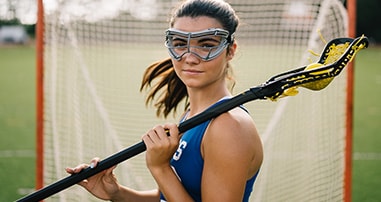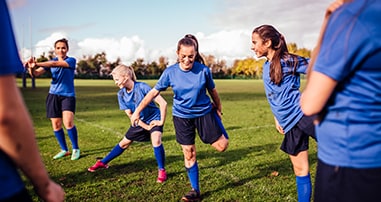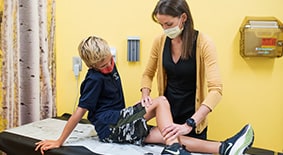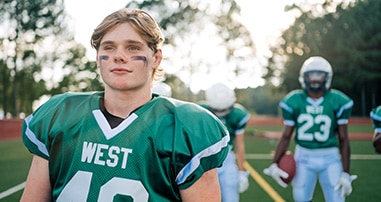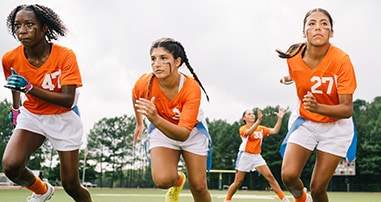Knee Pain and Knee Injuries
Weekend Clinic for Injuries
Sprains, strains and broken bones don’t wait for weekdays. If your child needs to see a pediatric orthopedic expert on a weekend, Children’s has appointments available on Saturdays in Sandy Springs and Sundays in Duluth. Make an appointment online or call 404-255-1933 to schedule.
Make an AppointmentKnee pain in kids and teens can be a result of traumatic knee injuries or repetitive overuse injuries from physical activity, such as competitive sports.
Some of the most common injuries to children and teens that cause knee pain include fractures, dislocations, and sprains and tears of soft tissues like ligaments and tendons. In many cases, injuries involve more than one structure in the knee.
At Children’s Healthcare of Atlanta, our pediatric orthopedic and sports medicine specialists are specially trained to recognize the specific signs and symptoms that may be causing your child’s or teen’s knee pain in order to make an accurate diagnosis and treatment plan.
Some of the common signs and symptoms of knee injuries include:
- A painful “popping” when walking or bending the knee
- Pain on the inside or outside of the knee
- Swelling around the knee
- Weakness of the knee
- Limited motion of the knee
- A feeling like the knee is locking up or getting stuck in place
- Localized or dull pain during activity
- A bump or knot around the knee
When should my kid see a doctor for knee pain?
The knee is the largest joint in the body, and it is made up of many important and complex structures. Injuries to the knee, especially for kids and teens who are still growing, can lead to short-term and long-term damage. If your child is experiencing knee pain, especially if you notice any limping, it is important that he temporarily stop activity and that you schedule an appointment to have your child’s knee evaluated by one of our specialists as soon as possible to help prevent potential additional knee damage.
It’s also important for kids and teens with knee pain and injuries to see an orthopedic or sports medicine specialist specifically trained to treat kids and teens. A pediatric-trained doctor will know how to diagnose and care for kids and teens to help avoid any long-term damage to the knees. The pediatric sports medicine orthopedic surgeons and sports medicine specialists at Children’s are specially trained to diagnose and treat kids from birth to age 18. We help your child recover as quickly as possible so that he can safely return to activities.
It is very common for children and teens to experience knee pain, especially for those who are playing sports. Commonly injured parts of the knee include the distal thighbone (femur), which is the end portion of the thighbone near the knee; proximal tibia (shinbone), which is the top portion of the tibia bone near the knee; tendons, which attach muscle to bone; and ligaments, which attach bone to bone.
What is an ACL injury?
The anterior cruciate ligament (ACL) is one of the four main knee ligaments, and it helps stabilize a child’s knee. It runs diagonally in the middle of the knee and connects the thighbone (femur) to the tibia (shinbone). It is one of the most commonly injured knee ligaments. Injury to the ACL may happen during activity when a child or teen is making cutting and pivoting movements, as well as when he’s landing after jumping, or from a direct blow to the knee. When an ACL is injured, it can be partially torn or completely torn, which could leave the knee unstable and at risk for worsening joint damage.
To learn more about the symptoms and causes of an ACL injury, the risks specific to children and teens, and how our team of pediatric-trained sports medicine specialists diagnose and treat a torn ACL, visit our ACL injury page.
What is jumper’s knee?
Also known as patellar tendonitis, jumper’s knee is an overuse injury of the patella tendon (tendon that connects the thigh muscle and kneecap to the shinbone) that can cause a child or teen to experience pain during activity.
What causes jumper’s knee?Jumper’s knee usually affects children and teens who play sports that involve a lot of jumping, squatting, climbing and running, including track and field, basketball, volleyball, gymnastics, running and soccer.
What are symptoms of jumper’s knee?The main symptom of jumper’s knee is knee pain at the front of the knee, though sometimes there may also be some swelling and joint stiffness. In mild cases, knee pain occurs after strenuous activity. The condition can become chronic if left untreated, and in severe cases, the tendon can tear or rupture. Your child will usually complain of pain just below the kneecap (patella). Bending and straightening the knee against resistance may also be painful.
How is jumper’s knee diagnosed?Jumper’s knee is diagnosed after your child undergoes a medical history and physical exam. Sometimes, an X-ray is needed.
How is jumper’s knee treated?Most cases of jumper’s knee require:
- Rest by limiting any painful movements.
- Icing the knee, which can help with pain and swelling. Try an ice cup massage. Fill a plastic foam cup with water and freeze it. When frozen, peel an inch of the plastic foam off from the bottom of the cup, and apply an ice massage directly to the injured area for five to 10 minutes. This can be repeated every 60 to 90 minutes as needed.
- Anti-inflammatory medications like ibuprofen (Motrin, Advil) or naproxen (Aleve), which can be taken as needed to help relieve pain and inflammation.
- Adequate support, which is important in reducing injury-causing stress. Taping or wearing a knee support or patellar tendon strap just under the kneecap may provide relief by stabilizing the kneecap.
- Sports physical therapy, which can help identify and correct issues that may contribute to the risk of injury. Some contributing factors that can be improved include weakness, decreased flexibility and poor core strength. A sports physical therapist can also help safely guide your child back to activities.
What is knee bursitis?
Knee bursitis, or prepatellar bursitis, is when the bursa (a small fluid-filled sac) that acts as a cushion between the bones, tendons and skin becomes inflamed, produces fluid and swells.
What causes knee bursitis?Knee bursitis can result from a direct hit to the front of the knee, chronic friction caused by frequent kneeling activities, joint overuse, conditions like gout and rheumatoid arthritis, an infection, or a direct hit or fall onto the kneecap (patella). Knee bursitis is very common in wrestling, but it can occur as a result of any activity, including sports like soccer, basketball and football.
What are symptoms of knee bursitis?Symptoms of knee bursitis include painful swelling over the front of the knee, usually above the kneecap. There may also be pain and stiffness when your child bends or straightens his knee.
How is knee bursitis diagnosed?Knee bursitis is usually diagnosed during a physical examination. Your child’s doctor may sometimes take a sample of fluid from the bursa to make sure it is not infected.
How is knee bursitis treated?Most cases of knee bursitis require:
- Elevating the knee, which can help decrease swelling.
- Icing the knee, which can help with pain and swelling. Try an ice cup massage. Fill a plastic foam cup with water and freeze it. When frozen, peel an inch of the plastic foam off from the bottom of the cup, and apply an ice massage directly to the injured area for five to 10 minutes. This can be repeated every 60 to 90 minutes as needed.
- Anti-inflammatory medications like ibuprofen (Motrin, Advil) or naproxen (Aleve), which can be taken as needed to help relieve pain and inflammation.
- Draining the bursa, which may be necessary if it becomes very swollen.
If the fluid inside the bursa becomes infected, the knee can become even more painful and may turn red and hot to the touch. With an infected knee bursitis, the fluid must be drained, and your child will be given antibiotics to treat the infection.
What is a kneecap fracture?
A kneecap fracture, also called a patella fracture, is a break in the kneecap. The kneecap acts as a shield for the knee joint, and a fracture of the kneecap can be very painful.
What causes a kneecap fracture?Patella fractures are most often caused by:
- Falling directly onto the knee.
- Receiving a direct blow to the knee.
- A sudden contraction of the quadriceps (thigh muscles), which can pull apart the patella.
The most common symptoms of a kneecap fracture include:
- Pain, bruising and swelling in the front of the knee
- Inability to straighten the knee or keep it extended during a straight leg raise
- Limping or inability to walk
- Pain when moving the knee
A doctor will need to examine your child and obtain imaging, such as an X-ray, a CT scan or an MRI, in order to confirm the diagnosis and rule out other possible problems.
How is a kneecap fracture treated?Treatment of a kneecap fracture may include:
- Bracing
- Casting
- Rest
- Sports physical therapy
- Surgery
What is kneecap instability?
The kneecap (patella), which rests in a groove at the end of the thighbone (femur), protects the knee joint and helps with knee extension. Kneecap instability is when the kneecap pops out of the groove.
What causes kneecap instability?Instability, or dislocation, of the kneecap usually occurs when the knee is extended and twisted. Direct collisions to the knee can also cause a patella dislocation.
What are symptoms of kneecap instability?Symptoms of kneecap instability may include knee pain, painful popping and swelling. You may also notice that your child’s kneecap is positioned on the outside of the knee or that his knee has an abnormal appearance.
How is kneecap instability diagnosed?During a physical examination, your child’s physician will assess range of motion, check stability and mobility, and pinpoint any tender areas. X-rays of the knee will be taken to show the alignment of the kneecap and check for fractures of the kneecap or femur.
Additional imaging, including an MRI or a CT scan, may be used to check for injuries to the bone or cartilage, to check for tears of the medial patellofemoral ligament or soft tissues, or to measure overall limb alignment.
How is kneecap instability treated?After a patella dislocation, the kneecap may spontaneously go back to its normal position, or your doctor may need to put it back in place.
Treatment options may include:
- Restricting activity and immobilization.
- Icing the knee, which can help with pain and swelling. Try an ice cup massage. Fill a plastic foam cup with water and freeze it. When frozen, peel an inch of the plastic foam off from the bottom of the cup, and apply an ice massage directly to the injured area for five to 10 minutes. This can be repeated every 60 to 90 minutes as needed.
- Anti-inflammatory medications like ibuprofen (Motrin, Advil) or naproxen (Aleve), which can be taken as needed to help relieve pain and inflammation.
- Adequate support, which is important in reducing injury-causing stress. A brace, strap or sleeve may provide relief by stabilizing the kneecap.
- Sports physical therapy, which can help identify and correct issues that may contribute to the risk of injury. Contributing factors that can be improved include weakness in quadriceps (front of thigh), decreased flexibility and poor core strength, and hip mechanics. A sports physical therapist can also help safely guide your child back to activities.
If your child or teen injures the cartilage lining the knee joint (articular cartilage), this could cause loose fragments of bone or cartilage within the joint, and pediatric sports surgery may be recommended. Children with recurrent kneecap instability may need surgery to stabilize the kneecap, repair structures (bone, muscle, tendons or ligaments) on the inside of the knee, release tight structures on the outside of the knee or modify the alignment of the leg.
Recurrent patella dislocations occur more commonly in children and are often a result of abnormal anatomy that increases the likelihood for children to dislocate the kneecap. Unlike adults, children have open growth plates to allow for continued bone growth.
When considering surgical options for your child’s recurrent patella dislocations, treatment options and timing may vary based on whether he has open or closed growth plates.
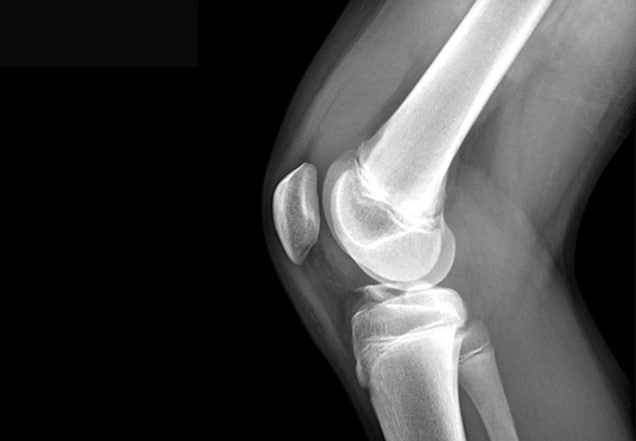
What is an MCL tear?
A medial collateral ligament (MCL) tear is a sprain or tear of the MCL, the ligament that helps stabilize the inside portion of the knee.
What causes an MCL tear?An MCL tear typically occurs when a child or teen:
- Suddenly changes direction or twists his knee while running.
- Jumps and lands in a way that twists the knee in an awkward position.
- Receives a direct hit to the outside of his knee while the foot is planted on the ground.
MCL sprains and tears are most common during activities that involve twisting, cutting and pivoting, such as skiing, soccer, football, basketball and tennis.
What are symptoms of an MCL tear?Oftentimes, a child or teen will say he heard or felt a “popping” in the knee at the time of an MCL injury, followed by pain on the inside of the knee. Swelling and knee weakness are also possible. After the swelling goes down, your child or teen may be able to walk, but he will usually still feel pain when the inside of the knee is stretched. He may also say that his knee feels unstable and “gives way,” making him stumble or fall.
How is an MCL tear diagnosed?To diagnose a torn MCL, a doctor will conduct a physical exam, pressing on your child’s knee and legs and moving them in certain ways to test the ligaments. The doctor may also order an X-ray and MRI to see if the MCL tear is partial or complete or if there is other damage.
How is an MCL tear treated?Treatment may include:
- Icing the knee, which can help with pain and swelling. Try an ice cup massage. Fill a plastic foam cup with water and freeze it. When frozen, peel an inch of the plastic foam off from the bottom of the cup, and apply an ice massage directly to the injured area for five to 10 minutes. This can be repeated every 60 to 90 minutes as needed.
- Anti-inflammatory medications like ibuprofen (Motrin, Advil) or naproxen (Aleve), which can be taken as needed to help relieve pain and inflammation.
- The PRICE method, which stands for protect (remove him from activities), rest, ice, compression (with an elastic bandage or compression brace) and elevation (raising the knee above the heart).
- Adequate support, which is important in reducing injury-causing stress. A brace can be worn to help protect the MCL and knee joint while your child heals.
- Using crutches if needed during recovery to not put too much pressure on the injured knee.
- Sports physical therapy, which can help identify and correct issues that may contribute to the risk of injury. Some contributing factors that can be improved include weakness, decreased flexibility and poor core strength. A sports physical therapist can also help safely guide your child back to activities.
- Surgery to repair the MCL tear.
What is Osgood-Schlatter disease?
Osgood-Schlatter disease, also called tibial tuberosity apophysitis, is an overuse injury of the cartilage growth plate just below the knee on the upper part of the shinbone in an area called the tibial tuberosity. This is where the patellar tendon inserts on the shinbone.
What causes Osgood-Schlatter?
Osgood-Schlatter is caused by repetitive, rigorous motion during sports that overworks the growth plate on the upper part of the shinbone and increases stress on the bone. Risk factors may include rapid growth, decreased flexibility, overlapping sports seasons, beginning a new sports season and playing year-round sports. This condition can occur with chronic repetitive tugging on the growth plate or with one specific event, such as a fall or sudden jump.
What are symptoms of Osgood-Schlatter?
Symptoms may include knee pain, inflammation, limping and possibly a bump or knot at the top of the shinbone. Boys ages 12 through 18 and girls ages 10 through 16 who are active in sports have the highest risk for Osgood-Schlatter.
How is Osgood-Schlatter diagnosed?
Osgood-Schlatter is diagnosed with a physical exam of your child’s knee. X-rays may be needed to rule out other conditions, and it may show an irregularity or fragmentation at the tibial tubercle, which is the bump under the kneecap (patella).
How is Osgood-Schlatter treated?
To treat Osgood-Schlatter, we recommend:
- Modifying workouts by cutting back on or eliminating painful running or jumping drills during practice time. Limiting quadricep (front of thigh) strengthening exercises and conditioning will lessen the irritation on the growth plate. Other activities, such as pushups, biking, sit-ups and low-impact skill drills, can be substituted until the knee pain subsides.
- Icing the knee, which can help with pain and swelling. Try an ice cup massage. Fill a plastic foam cup with water and freeze it. When frozen, peel an inch of the plastic foam off from the bottom of the cup, and apply an ice massage directly to the injured area for five to 10 minutes. This can be repeated every 60 to 90 minutes as needed.
- Anti-inflammatory medications like ibuprofen (Motrin, Advil) or naproxen (Aleve), which can be taken as needed to help relieve pain and inflammation.
- Protective padding to protect the knees from a direct hit or fall and to provide adequate support, which is important in reducing injury-causing stress. A brace, strap or sleeve may provide relief by stabilizing the kneecap.
- Sports physical therapy, which can help identify and correct issues that may contribute to the risk of injury. Some contributing factors that can be improved include weakness, decreased flexibility and poor core strength. A sports physical therapist can also help safely guide your child back to activities.

What is OCD ?
Osteochondritis dissecans (OCD) is a joint condition in which the bone underneath the cartilage lining a joint—in this case, the knee—dies. The bone and cartilage can then break loose, causing pain and possibly obstructing joint motion.
What causes OCD?Doctors are not exactly sure what causes OCD, but it may be due to a loss of the blood supply to the bone or repeated stress on the knee from sports or other activities. It is also thought to be genetic, as the condition can run in families. OCD lesions usually happen in kids or teens between 10 and 20 years old who are very active, such as those playing sports like gymnastics, baseball and soccer. Lesions also tend to happen in people whose bones are not straight—for example, anyone with bowlegs or knock knees.
What are symptoms of OCD?Symptoms may vary, but the most common include:
- Pain and swelling
- Locking or “catching” of the knee joint
- Increased pain with activity in the knee
- A “giving way” sensation in the knee
To diagnose OCD, your child will first undergo a physical exam, and the doctor will ask about any sports or activities he engages in and his symptoms. The doctor may also recommend an X-ray or MRI.
How is OCD treated?Treatment of OCD may include:
- Complete rest and usually no weight bearing at all to avoid any motion that may cause pain. Then light activities of daily living and weight bearing, without pain, can be introduced slowly.
- Casting, splinting or bracing the joint to keep it still.
- Avoiding sports and other intense activities.
- Sports physical therapy, which can be very effective in eliminating pain, preventing further injury, helping with flexibility and strength, and helping guide your child with a gradual return to activities once cleared by your child’s doctor.
- Surgery:
- If there is no improvement after rest and sports physical therapy.
- If a piece of the bone or cartilage breaks away completely.
- To fix an underlying problem that is contributing to the development of the OCD lesion, such as bowlegs or knock knees.
What is runner’s knee?
Runner’s knee, or patellofemoral stress syndrome, is an overuse injury that develops because of repetitive pressure between the kneecap (patella) and thighbone (femur).
What causes runner’s knee?There are many contributing factors that may cause runner’s knee, including flat or pronated (collapsed arch) feet, knees that turn in while running or jumping, muscle imbalances, insufficient training, and wearing shoes without enough support. Proper stretching and strengthening of the muscles around the knee can help reduce the risk for injury. Runner’s knee is common in runners and children who play sports like soccer, lacrosse and volleyball.
What are symptoms of runner’s knee?Symptoms of runner’s knee may include:
- Aching pain around or under the kneecap that worsens during activities like squatting, climbing stairs, jumping and running
- A feeling of stiffness after sitting for a long time
- Weakness in the knees
- Occasional buckling of the knees
Your child’s doctor will perform a physical exam. An X-ray may be needed to confirm the diagnosis or rule out other causes of knee pain, such as a kneecap instability.
How is runner’s knee treated?Most cases of runner’s knee require:
- Modifying workouts and avoiding activities that worsen the knee pain. Runners may have to cut back on the distance they run or change their routes to avoid hills or hard surfaces.
- Icing the knee, which can help with pain and swelling. Try an ice cup massage. Fill a plastic foam cup with water and freeze it. When frozen, peel an inch of the plastic foam off from the bottom of the cup, and apply an ice massage directly to the injured area for five to 10 minutes. This can be repeated every 60 to 90 minutes as needed.
- Anti-inflammatory medications like ibuprofen (Motrin, Advil) or naproxen (Aleve), which can be taken as needed to help relieve pain and inflammation.
- Adequate support, which is important in reducing injury-causing stress. Make sure that shoes are not too worn and that your child has adequate support. A brace, strap or sleeve may provide relief by stabilizing the kneecap.
- Sports physical therapy, which can be very effective in eliminating pain and preventing further injury. Strengthening and stretching the quadriceps (front-thigh muscles) and hamstrings (back-thigh muscles) can help.
What is SLJ syndrome?
Sinding-Larsen-Johansson (SLJ) syndrome is a condition that occurs near the bottom of the kneecap (patella). It involves the patella tendon, which connects the kneecap to the shinbone (tibia). The growth plate at the bottom of the kneecap becomes irritated and inflamed.
What causes SLJ syndrome?Repetitive stress, rapid growth, decreased flexibility and overuse can cause SLJ. It is a common injury in growing athletes between the ages of 7 and 13 who participate in sports that may require repetitive running and jumping.
What are symptoms of SLJ syndrome?Symptoms of SLJ may include:
- Pain at the front of the knee, near the bottom of the kneecap
- Swelling and tenderness around the kneecap
- Knee pain that increases with exercise or activities like running, climbing stairs or jumping
- Knee pain that becomes more severe when kneeling or squatting
- A swollen or bony bump at the bottom of the kneecap
To diagnose SLJ, your child will undergo a physical exam. The doctor will ask about his symptoms and any sports or activities he engages in. The doctor may also recommend an X-ray or MRI.
How is SLJ syndrome treated?
Most cases of SLJ require:
- Modifying workouts by decreasing or eliminating painful running or jumping drills during practice time. Limiting quadricep (front of thigh) strengthening exercises and conditioning will lessen the irritation on the growth plate. Other activities, such as pushups, sit-ups and low-impact skill drills, can be substituted until the knee pain subsides.
- Icing the knee, which can help with pain and swelling. Try an ice cup massage. Fill a plastic foam cup with water and freeze it. When frozen, peel an inch of the plastic foam off from the bottom of the cup, and apply an ice massage directly to the injured area for five to 10 minutes. This can be repeated every 60 to 90 minutes as needed.
- Anti-inflammatory medications like ibuprofen (Motrin, Advil) or naproxen (Aleve), which can be taken as needed to help relieve pain and inflammation.
- Protective padding to protect the knees from a direct hit or fall and provide extra support, which is important in reducing injury-causing stress. A brace, strap or sleeve may provide relief by stabilizing the kneecap.
- Supportive footwear, which can provide shock absorption and pain relief when your child or teen is running and jumping.
- Sports physical therapy, which can help identify and correct issues that may contribute to the risk of injury. Contributing factors that can be improved include weakness, decreased flexibility and poor core strength.
What is symptomatic plica?
A plica is a fold in the thin connective tissue that lines the knee joint and allows your child to bend and move his leg with ease. Although rare, when a plica becomes inflamed, enlarged or irritated and causes symptoms, the condition is known as symptomatic plica.
What causes symptomatic plica?A plica injury typically causes symptoms after a rapid growth spurt or from a direct blow to the area. It is believed that the plica and overlying connective tissue become thickened and begin to catch or impinge between the kneecap (patella) and thighbone (femur), causing knee pain.
It is not uncommon for symptomatic plica to occur at the onset of a new sports season or with a sudden increase of training levels. Athletes participating in track, cross-country, soccer, football and cycling are especially vulnerable to plica injury.
What are symptoms of symptomatic plica?Symptoms can occur suddenly (acute) or over time (chronic). Persistent knee pain during activity is the most common symptom, but sometimes athletes will also experience what is commonly called a locked knee.
How is symptomatic plica diagnosed?A doctor will need to examine your child to make the diagnosis and rule out other possible problems. He may also obtain an X-ray or MRI to confirm the diagnosis. There is no one test that definitively diagnoses symptomatic plica.
How is symptomatic plica treated?Most symptomatic plica can be treated without surgery. Sports physical therapy may be recommended to help your child or teen improve strength and mobility, as well as to prevent future injury of the plica.
What is a tibial spine fracture?
A tibial spine fracture occurs when the ACL is stretched and pulls the tibial spine (a bony ridge at the top of the tibia, or shinbone) away from the rest of the bone.
Common complications of a tibial spine fracture are knee stiffness or instability, which resemble those of an ACL tear or knee sprain.
What causes a tibial spine fracture?This fracture can happen when the knee is extended too far or twisted. It is more common in children because a child’s ACL is stronger than the still-growing tibia.
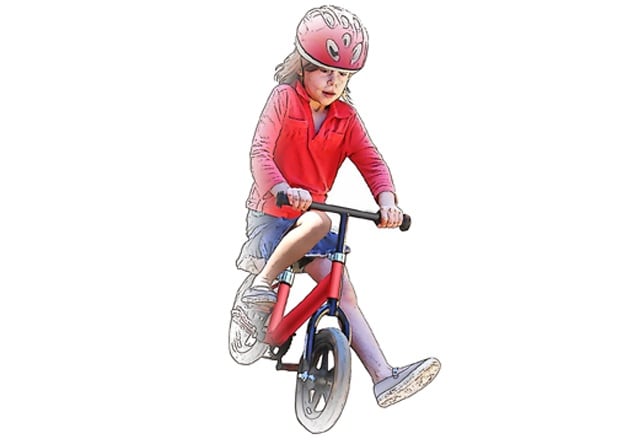 What are symptoms of a tibial spine fracture?
What are symptoms of a tibial spine fracture?
Your child may have a tibial spine fracture if he experiences the following:
- Knee pain
- A popping sensation in the knee
- Swelling
- Inability to put weight on the knee
- Inability to straighten the knee completely
After a physical exam, an X-ray or MRI can help diagnose the fracture properly. This is the best way to make sure your child gets the right treatment.
How is a tibial spine fracture treated?If the tibial spine is not displaced, or separated from the rest of the bone, a tibial spine fracture can be treated without surgery by lining up the bone correctly and casting it.
If the tibial spine fracture is more severe, surgery will be needed to help it properly heal. In many cases, a minimally invasive procedure known as an arthroscopic procedure can be used to put the fractured fragment back into place and secure it appropriately. This procedure involves placing two pins in the knee. The pins pull a suture over the tibial ridge to pull it into the right position. By treating the tibial spine fracture this way, a pediatric orthopedic surgeon can properly repair the fracture and avoid damaging the growth plate nearby.

What is a tibial tubercle fracture?
The tibial tubercle is the bump at the top of the shinbone (tibia) where the patellar tendon attaches. A tibial tubercle fracture is an uncommon knee injury in growing athletes that can result from a forced extension of the knee opposed to a fixed leg.
What causes a tibial tubercle fracture?A tibial tubercle fracture occurs when a child lands on a straight knee after a jump or from attempting a forceful knee extension (straightening) when the leg is blocked from moving, such as when your child is trying to kick a soccer ball but hits the ground instead.
What are symptoms of a tibial tubercle fracture?Symptoms of a tibial tubercle fracture may include:
- Onset of sudden knee pain, usually at the start of a jump or sprint
- Inability for a child or teen to move his knee
- Limping
- Swelling and pain at the top of the shinbone
A doctor will need to examine your child to make the diagnosis and rule out other possible problems. He will obtain an X-ray and possibly an MRI to confirm the diagnosis.
How is a tibial tubercle fracture treated?When the tibial tubercle is fractured, it often needs to be fixed surgically to help make sure the knee can continue to be straightened. The fracture is typically repaired with a few screws, and your child is immobilized in either a cast or knee brace for approximately six weeks. Once the cast is removed, sports physical therapy is often necessary to help strengthen the quadriceps (front-thigh muscles).
What is a torn meniscus?
A meniscus is the rubbery tissue in the knee that serves as a cushion between the shinbone (tibia) and the thighbone (femur), protecting the knee joint and assisting the ligaments by providing stability to the knee joint.
What causes a torn meniscus?A meniscus can tear when a child twists his knee, squats or sustains significant trauma. Since a meniscus is made of specialized cartilage, injuries to it are commonly referred to as torn cartilage.
Children under 12 years old rarely tear the meniscus, but if a child sustains a meniscus tear, it is usually from significant trauma. However, it can also occur if your child has abnormal cartilage. This is called a discoid meniscus, which is an abnormality of the structure of the meniscus. Instead of the meniscus having its typical c-shape, the center of the cartilage is filled in to varying degrees. A discoid meniscus can be thick and round, which causes it to snap when the knee performs a range of motions. It can also tear randomly in very young children. Typically, only one knee is affected.
What are symptoms of a torn meniscus?Symptoms of a torn meniscus may include:
- Knee pain
- Limited motion
- Swelling of the knee joint
- Knee locking or getting stuck in place
After a physical exam, an MRI is performed to confirm the diagnosis. Radiology tests, such as an X-ray or a CT scan, may also be ordered to rule out additional injuries.
How is a torn meniscus treated?
Since a torn meniscus rarely heals on its own, it is best to have it surgically treated. Left untreated, there can be further damage or tearing of the remaining meniscus, or even worse, to the joint surface (articular cartilage).
Treatment of a torn meniscus depends on the type of tear:
- Incomplete: If the tear involves only a portion of the meniscus—an incomplete or partial thickness tear—it may not need treatment. This is commonly seen in association with ligament injuries.
- Inner: If the meniscus tear occurs in the inner two-thirds of the cartilage, where there is no blood supply, it will not heal. The tear is treated by trimming away the torn portion of the meniscus and leaving as much of the normal meniscus behind as possible.
- Outer: If the tear is in the outer third of the meniscus, where there is a naturally occurring blood supply, it has the potential for healing. In many of these cases, the meniscus can be sutured, or tied, together.
Treatment for a torn meniscus typically includes:
- Rest, including the use of crutches.
- Surgery, depending on the type of tear.
- Icing the knee, which can help with pain and swelling. Try an ice cup massage. Fill a plastic foam cup with water and freeze it. When frozen, peel an inch of the plastic foam off from the bottom of the cup, and apply an ice massage directly to the injured area for five to 10 minutes. This can be repeated every 60 to 90 minutes as needed.
- Anti-inflammatory medications like ibuprofen (Motrin, Advil) or naproxen (Aleve), which can be taken as needed to help relieve pain and inflammation.
- Sports physical therapy, which can help identify and correct issues that may contribute to the risk of injury. Contributing factors that can be improved include weakness, decreased flexibility and poor core strength.
Treatments for a knee injury will vary depending on the type and severity of the injury. Treatments may range anywhere from rest and sports physical therapy to surgery.
Whether your child or teen has suffered a minor sprain or a complete ACL tear, any type of knee swelling is not normal. If your child has knee swelling, knee pain or knee stiffness, take him to a pediatric sports medicine specialist right away for an evaluation.
While your child is waiting to be seen, doctors recommend you start treating him at home using the PRICE method:
- Protection: Keep your child comfortable and sedentary when possible. Remove him from sports practice or games to avoid worsening a possible injury.
- Rest: Keep movement to a minimum.
- Ice: Icing the knee can help with pain and swelling. Try an ice cup massage. Fill a plastic foam cup with water and freeze it. When frozen, peel an inch of the plastic foam off from the bottom of the cup, and apply an ice massage directly to the injured area for five to 10 minutes. This can be repeated every 60 to 90 minutes if needed.
- Compression: Use compression bandages to help improve comfort levels.
- Elevation: Keep your child’s knee elevated above the heart and propped up on something soft.
Through proper training and conditioning, and by following healthy guidelines, the risk of knee injuries can be reduced in kids and teens.
Our pediatric orthopedic and sports medicine specialists, who focus on injury prevention and rehabilitation, have created knee injury prevention exercises so that your child or teen can get back into his active routine as soon—and as safely—as possible.
Prevention treatments our physicians recommend include:
- Participate in sports physical therapy, which can help identify and correct issues that may contribute to the risk of injury. Contributing factors that can be improved include weakness, decreased flexibility and poor core strength.
- Perform injury prevention exercises.
- Participate in strength training.
- Play only one sport (on one team) at a time.
- Start conditioning several weeks before the start of a new sports season to avoid the “too much, too soon” trap.
- Stretch to maintain and improve flexibility, especially during growth spurts.
This content is general information and is not specific medical advice. Always consult with a doctor or healthcare provider if you have any questions or concerns about the health of a child. In case of an urgent concern or emergency, call 911 or go to the nearest emergency department right away. Some physicians and affiliated healthcare professionals on the Children’s Healthcare of Atlanta team are independent providers and are not our employees.
Parent Resources
Contact Us 404-255-1933
